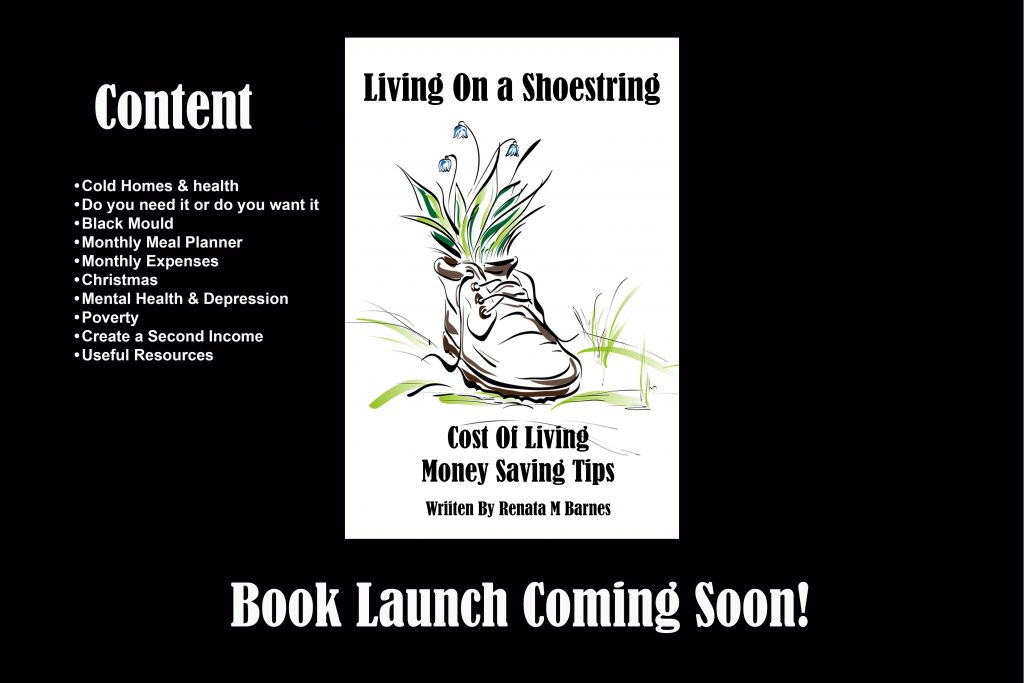Disclaimer:
Renata Barnes (iRenata), does not provide financial advice, and any information shared should not be construed as such. Additionally, there is no guarantee or claim that the principles of neuroplasticity, discussed or mentioned in any context, will work universally for everyone. Neuroplasticity is a complex and individualized concept, and its effectiveness can vary based on numerous factors. Any discussions or information presented by Renata Barnes (iRenata) are intended for general informational purposes only and should not be considered as personalized financial advice. Individuals seeking financial guidance are encouraged to consult with qualified professionals who can assess their specific circumstances and provide tailored recommendations. Renata Barnes (iRenata) disclaims any liability for decisions made or actions taken based on the information provided, and users of this information should use their discretion and seek professional advice when needed.
Keys to Success in Life and Business: A Comprehensive Guide
Success in life and business is a pursuit that many aspire to achieve. However, the path to success is often challenging, requiring a combination of determination, resilience, and strategic decision-making. In this guide, we will explore key principles and practical steps that can help individuals achieve success in both their personal and professional lives.
- Set Clear Goals: Defining clear and achievable goals is the first step towards success. Whether in life or business, having a roadmap provides direction and purpose. Break down your goals into smaller, manageable tasks, and create a timeline to track progress.
- Continuous Learning: The world is constantly evolving, and successful individuals embrace a mindset of continuous learning. Stay informed about industry trends, acquire new skills, and seek out opportunities for personal and professional development. This commitment to learning will give you a competitive edge.
- Develop a Strong Work Ethic: Success often requires hard work, dedication, and perseverance. Cultivate a strong work ethic by setting high standards for yourself and consistently putting in the effort required to achieve your goals. Be disciplined and prioritize your responsibilities.
- Build and Nurture Relationships: Networking is a crucial aspect of success, both in life and business. Cultivate meaningful relationships with peers, mentors, and industry professionals. Networking not only provides valuable insights but can also open doors to new opportunities and collaborations.
- Adaptability and Resilience: The ability to adapt to change and bounce back from setbacks is essential. The business landscape is dynamic, and unexpected challenges are inevitable. Resilience allows you to overcome obstacles, learn from failures, and emerge stronger.
- Financial Literacy: Whether in personal finance or business, understanding financial principles is crucial. Learn to manage budgets, invest wisely, and make informed financial decisions. Financial literacy is a cornerstone of long-term success.
- Effective Time Management: Time is a valuable resource, and successful individuals know how to manage it effectively. Prioritize tasks, set deadlines, and avoid procrastination. Time management skills help maximize productivity and contribute to achieving goals.
- Innovation and Creativity: Innovation is key to staying ahead in business and life. Encourage creativity, embrace new ideas, and be open to unconventional solutions. The ability to innovate sets successful individuals apart in a rapidly changing world.
- Emotional Intelligence: Success is not only about technical skills but also about understanding and managing emotions. Develop emotional intelligence to navigate interpersonal relationships, resolve conflicts, and lead with empathy.
- Give Back to Others: Success is more fulfilling when shared. Actively contribute to your community or industry. Mentorship, volunteering, and philanthropy not only make a positive impact but also create a sense of purpose beyond personal success.
Harnessing Neuroplasticity and the Law of Attraction: The Power of The Mind In Business
Achieving success in business often involves harnessing the principles of neuroplasticity, the law of attraction, and the power of the mind. Neuroplasticity underscores the brain’s remarkable ability to adapt and rewire itself based on experiences and thoughts. By cultivating a growth mindset and embracing continuous learning, individuals can enhance their cognitive abilities and adapt to the ever-evolving business landscape. The law of attraction emphasizes the idea that positive thoughts attract positive outcomes, encouraging individuals to visualize and manifest their goals. Combined with the power of the mind, which involves cultivating focus, resilience, and determination, these principles create a powerful foundation for success in business. Successful entrepreneurs often leverage these concepts to shape their mindset, overcome challenges, and manifest opportunities, fostering a proactive and innovative approach to their professional endeavors.
Neuroplasticity, the brain’s remarkable ability to reorganize itself by forming new neural connections, and the Law of Attraction, the belief that positive or negative thoughts bring positive or negative experiences into a person’s life, are two powerful concepts that intersect in the realm of personal development and well-being.
Understanding Neuroplasticity:
Neuroplasticity, often referred to as the brain’s ability to rewire itself, challenges the conventional belief that the brain’s structure is fixed and unchangeable after a certain age. Neuroscience research has shown that the brain is adaptable, and experiences, thoughts, and emotions can reshape its neural pathways. This adaptability, known as neuroplasticity, provides the foundation for personal growth and transformation.
How Neuroplasticity and the Law of Attraction Align:
The Law of Attraction operates on the premise that our thoughts and feelings emit vibrational frequencies that attract similar energies from the universe. Neuroplasticity complements this concept by explaining how our repeated thoughts and emotions can create physical changes in the brain. When we consistently focus on positive thoughts and feelings, we reinforce neural pathways associated with optimism, resilience, and success.
Practical Strategies for Harnessing Neuroplasticity and the Law of Attraction:
- Visualization Techniques: Engage in regular visualization exercises where you vividly imagine achieving your goals. Neuroplasticity suggests that repetitive visualization strengthens neural connections associated with success, making it more likely to manifest in your life.
- Affirmations and Positive Thinking: Use positive affirmations to cultivate a mindset aligned with your desired outcomes. By consistently affirming positive beliefs, you reinforce neural pathways that support a constructive and optimistic perspective.
- Mindfulness and Meditation: Practicing mindfulness and meditation enhances neuroplasticity by promoting structural changes in the brain associated with improved focus, emotional regulation, and stress resilience. These practices also align with the Law of Attraction by fostering a positive and present mindset.
- Gratitude Journaling: Keep a gratitude journal to shift your focus toward positive aspects of your life. Regularly acknowledging and appreciating what you have activated neuroplasticity, rewiring your brain to notice and attract more positive experiences.
- Setting Clear Intentions: Clearly define your goals and intentions, aligning them with positive emotions. Neuroplasticity suggests that this clarity activates brain regions associated with motivation and goal pursuit, while the Law of Attraction amplifies the likelihood of achieving those goals through vibrational alignment.
The convergence of neuroplasticity and the Law of Attraction underscores the profound impact our thoughts and emotions can have on shaping our reality. By understanding and actively leveraging these principles, individuals can embark on a transformative journey toward personal growth, achievement, and a more fulfilling life. Embracing a positive mindset, supported by the rewiring capabilities of the brain, empowers individuals to attract and manifest the experiences they desire.
Exploring the Monroe Institute: Unveiling the Mysteries of Brain Waves, Alpha, and Theta States
Founded by Robert Monroe in the early 1970s, the institute gained fame for its research into altered states of consciousness and the use of binaural beats to induce these states. Central to their work is the understanding of brain waves, particularly the alpha and theta states, and their profound impact on human consciousness.
The Spectrum of Brain Waves:
- Beta Waves:
- Frequency (Hz): 14-30
- State: Awake and alert
- Function: Associated with logical thinking, problem-solving, and active concentration.
- Alpha Waves:
- Frequency (Hz): 8-13
- State: Relaxed and calm
- Function: Prevalent during daydreaming, meditation, and creative visualization. The gateway to altered states of consciousness.
- Theta Waves:
- Frequency (Hz): 4-7
- State: Deep relaxation, meditation, and light sleep
- Function: Linked to creativity, intuition, and access to deeper levels of consciousness.
- Delta Waves:
- Frequency (Hz): 0.5-4
- State: Deep sleep
- Function: Critical for physical and mental restoration, and release of growth hormone.
The Monroe Institute’s Contribution:
The Monroe Institute gained recognition for its development of Hemi-Sync (hemispheric synchronization) technology. Using binaural beats — a technique where two slightly different frequencies are presented to each ear, creating a perceived third frequency — Hemi-Sync aims to induce specific brain wave patterns, facilitating altered states of consciousness.
- Alpha State Exploration:
- Through Hemi-Sync, individuals can enter the alpha state more easily, experiencing profound relaxation and enhanced receptivity to creative inspiration. This state is conducive to meditation, self-discovery, and stress reduction.
- Theta State Journeys:
- The institute’s programs guide participants into the elusive theta state, associated with deep meditation, heightened intuition, and a connection to the subconscious mind. In this state, individuals may explore expanded realms of consciousness and gain insights beyond ordinary perception.
Applications Beyond the Institute:
- Enhanced Learning:
- Alpha and theta states have been linked to improved learning and information retention. The Monroe Institute’s work suggests that accessing these states through Hemi-Sync can optimize the learning experience.
- Stress Reduction and Meditation:
- The institute’s programs have proven beneficial for stress reduction and meditation. By guiding individuals into relaxed states, participants report a greater sense of inner calm and mental clarity.
- Creative Exploration:
- Alpha and theta states are fertile grounds for creativity. The Monroe Institute’s approach provides a structured yet flexible framework for individuals to tap into their creative potential.
The Monroe Institute’s exploration of brain waves and altered states of consciousness has not only expanded our understanding of the mind but has also introduced practical applications for personal development and well-being. By delving into the realms of alpha and theta states through innovative technologies like Hemi-Sync, the institute continues to pave the way for individuals seeking to unlock the full potential of their minds and explore the mysteries of human consciousness. https://www.monroeinstitute.org/
People Who Have Used Neuroplasticity & Manifestation:
Numerous individuals across various fields have harnessed the power of neuroplasticity to achieve success and overcome challenges. While it’s important to note that success is subjective and varies from person to person, here are some notable figures who have utilized neuroplasticity to enhance their lives and careers:
- Michael Merzenich: A neuroscientist who has extensively researched neuroplasticity. His work has contributed significantly to our understanding of the brain’s ability to adapt and change throughout life.
- Barbara Arrowsmith-Young: Overcoming her learning disabilities, Arrowsmith-Young developed a cognitive training program based on neuroplasticity principles. The Arrowsmith Program has helped many individuals improve their cognitive functions and academic performance.
- Norman Doidge: A psychiatrist and author of “The Brain That Changes Itself,” Doidge has popularized the concept of neuroplasticity through his writings, showcasing stories of individuals who have transformed their lives by rewiring their brains.
- Jill Bolte Taylor: A neuroanatomist who experienced a stroke and documented her journey in the book “My Stroke of Insight.” Taylor’s story emphasizes the brain’s capacity for recovery and adaptation.
- Henry Molaison (H.M.): Though not a figure in the traditional sense, H.M. was a patient whose case contributed significantly to our understanding of memory and neuroplasticity. His experiences after brain surgery led to insights into the brain’s ability to reorganize functions.
- Rick Hanson: A psychologist and author of “Hardwiring Happiness,” Hanson focuses on the positive aspects of neuroplasticity. He provides practical strategies for rewiring the brain to cultivate lasting happiness and well-being.
- Paul Bach-y-Rita: A neuroscientist known for his work in sensory substitution, Bach-y-Rita’s research showcased how the brain can adapt to compensate for sensory deficits, opening new possibilities for rehabilitation.
- Edward Taub: A neuroscientist who developed Constraint-Induced Movement Therapy (CIMT) to help individuals with motor impairments regain movement. His approach is rooted in the principles of neuroplasticity.
- Jeff Hawkins: An entrepreneur and neuroscientist who co-founded Palm Computing and Handspring, Hawkins has applied his understanding of the brain to create innovative technologies. He authored “On Intelligence,” exploring the connections between neuroscience and artificial intelligence.
- Daniel Tammet: An autistic savant known for his extraordinary abilities in mathematics and language. Tammet’s brain functions differently, showcasing the brain’s remarkable capacity for unique adaptations.
- Jim Carrey: The renowned actor and comedian Jim Carrey has spoken about his journey of self-discovery and personal growth. Carrey’s perspective often touches on the power of positive thinking, visualization, and affirmations. He famously wrote himself a check for $10 million dated for five years in the future when he was a struggling actor. Eventually, he received a movie role that paid him exactly that amount.
- Oprah Winfrey: Oprah Winfrey, a media mogul and cultural icon, has been an advocate for personal development and mindfulness. She has discussed her use of practices such as gratitude journaling, meditation, and positive affirmations. Oprah’s emphasis on self-awareness, resilience, and gratitude aligns with principles associated with neuroplasticity.
- Napoleon Hill: Napoleon Hill, a pioneering self-help author and motivational speaker, is best known for his landmark book “Think and Grow Rich,” published in 1937. Although Hill did not use the term “neuroplasticity” in his writings, the principles he outlined align with some aspects of the concept.
- Neville Goddard: Neville Goddard, a 20th-century mystic and influential spiritual teacher, shared insights that, while predating the formal concept of neuroplasticity, resonate with the principles of the brain’s adaptability. Goddard’s teachings emphasized the power of imagination and the influence of mental imagery on one’s reality.
- Morris E. Goodman: born on November 9, 1945, is an American motivational speaker and author renowned for his incredible story of survival and resilience. Often referred to as the “Miracle Man,” Goodman’s life took a dramatic turn in March 1981 when his single-engine plane crashed, leaving him paralyzed from the neck down. Despite grim prognoses and doctors believing he would never walk or breathe without a respirator again, Goodman defied all odds and embarked on a remarkable journey of recovery.
- Bob Proctor: Bob Proctor was a renowned personal development coach and speaker who has made significant contributions to the field of self-improvement. While he may not be directly associated with the scientific study of neuroplasticity, his teachings often align with the concept. Proctor emphasized the power of positive thinking, belief in oneself, and the impact of thoughts on one’s reality.
- Dr.Caroline Leaf: Dr. Caroline Leaf is a cognitive neuroscientist and communication pathologist who has become a prominent figure in the field of neuroplasticity. With a focus on the mind-brain connection, Dr. Leaf’s work delves into the remarkable adaptability of the brain and its potential for change. Her research underscores the concept of neuroplasticity, emphasizing the brain’s ability to rewire itself based on our thoughts and experiences.
- Mansa Musa: Mansa Musa, the 14th-century ruler of the Mali Empire, was renowned for his immense wealth, often considered one of the richest individuals in history. While not explicitly discussed in historical records, the power of thought, perseverance, and visionary leadership could have been essential elements in Mansa Musa’s success as a ruler and in accumulating the wealth for which he was renowned.
- John Assaraf: John Assaraf is a successful entrepreneur, author, and speaker known for his expertise in the field of mindset and personal development. Co-author of the bestselling book “The Secret,” Assaraf gained widespread recognition for his contributions to the concept of the law of attraction. He is also the founder of NeuroGym, a company focused on combining neuroscience with personal growth strategies. Assaraf’s work often revolves around the idea that individuals can achieve their goals by harnessing the power of their minds.
- Jack Canfield: Jack Canfield is a widely recognized motivational speaker, author, and success coach who has left an indelible mark in the field of personal development. Best known as the co-creator of the highly successful “Chicken Soup for the Soul” series, Canfield has co-authored numerous books that aim to inspire and empower individuals to reach their full potential.
- Dr Joe Vitale: Dr. Joe Vitale is a renowned author, motivational speaker, and self-help expert who has made significant contributions to the field of personal development. With a background in marketing and metaphysics, Vitale is perhaps best known for his appearance in the popular film and book “The Secret,” where he discussed the law of attraction. His work often explores the relationship between the mind and success, emphasizing the role of beliefs and thoughts in shaping one’s reality.
- Bob Doyle: Bob Doyle is an accomplished author, speaker, and expert in the field of personal development, best known for his contribution to the film and book “The Secret.” As one of the featured teachers in “The Secret,” Doyle gained recognition for his insights into the law of attraction and the power of positive thinking.
- Mike Dooley: Mike Dooley is a renowned author, speaker, and entrepreneur known for his inspirational and motivational work in the realm of personal development. As the author of “Infinite Possibilities: The Art of Living Your Dreams” and the creator of the Notes from the Universe series, Dooley shares profound insights into the principles of manifestation and the unlimited potential of individuals.
- Lisa Nichols: Lisa Nichols is a dynamic author, motivational speaker, and life coach celebrated for her transformative work in personal development and empowerment. Best known for her appearance in the self-help documentary “The Secret,” Nichols has authored several books, including “No Matter What!” and “Abundance Now.” Her teachings revolve around the principles of resilience, self-love, and the law of attraction. Nichols, having overcome personal challenges, shares her powerful story to inspire others to break through limitations and pursue their dreams.
- Bill Harris: Bill Harris, who passed away in 2018, was associated with the Centerpointe Research Institute and was the creator of the Holosync audio technology. Holosync is a form of audio meditation that uses binaural beats to stimulate the brain and promote relaxation and personal development. While Bill Harris and Holosync are not directly associated with “The Secret,” their contributions to the field of personal growth have left an impact on individuals seeking tools for meditation and self-improvement.
- Robert Monroe: Robert Monroe was a pioneer in the exploration of human consciousness and the founder of the Monroe Institute. His groundbreaking work involved the development of audio technologies, such as Hemi-Sync, designed to facilitate altered states of consciousness and enhance meditation experiences. While Monroe’s focus was primarily on exploring the realms of consciousness, his work indirectly intersected with Project Stargate, a U.S. government program that investigated psychic phenomena. Project Stargate explored the potential applications of psychic abilities for military and intelligence purposes. Although Monroe himself was not directly involved in Project Stargate, his research influenced the broader understanding of consciousness and its capabilities. The Monroe Institute’s contributions align with the principles of neuroplasticity, suggesting that the brain can adapt and reorganize itself based on experiences. Additionally, the exploration of altered states of consciousness and expanded awareness in Monroe’s work may resonate with the concept of manifestation, as individuals could potentially tap into higher states of consciousness to influence their reality.
- Jake Ducey: Jake Ducey is a motivational speaker, author, and advocate for personal development known for his focus on manifestation and the power of the mind. In his work, Ducey often explores the principles of the law of attraction, encouraging individuals to shape their reality through positive thoughts and beliefs. He emphasizes the idea that one can manifest their desires by aligning their mindset with their goals. Ducey’s teachings often align with the concept of neuroplasticity, suggesting that the brain can adapt and rewire itself based on the thoughts and experiences one engages in consistently. By promoting the potential for positive change through intentional thinking, Jake Ducey inspires individuals to harness the transformative power of their minds for personal growth and success.
- Dr. John Hagelin: Dr. John Hagelin is a quantum physicist, educator, and researcher known for his work on the unification of physics and consciousness. He has made significant contributions to the field of theoretical physics, particularly in the development of the Grand Unified Field Theory. Beyond his academic pursuits, Dr. Hagelin is recognized for his involvement in the field of meditation and consciousness. He is associated with the Transcendental Meditation (TM) movement and has researched the impact of group meditation on societal stress and crime rates. Dr. Hagelin’s interdisciplinary approach bridges the gap between science and spirituality, exploring the connection between consciousness and the underlying fabric of the universe. His work emphasizes the potential for transformative change through the understanding and utilization of consciousness in the pursuit of personal and collective well-being.
- Dr. John Demartini: Dr. John F. Demartini is a renowned author, speaker, and human behavior expert who has made significant contributions to the fields of personal development and self-help. With a background in chiropractic medicine and extensive studies in various disciplines, including theology, physics, and psychology, Dr. Demartini’s teachings offer a holistic approach to understanding human behavior and potential. He is best known for his work in the field of the Demartini Method, a transformative process designed to help individuals break through emotional and mental barriers. Dr. Demartini’s presentations often focus on the interconnectedness of the mind, body, and spirit, emphasizing the importance of aligning one’s values with their goals for a more fulfilling life. Through his books, seminars, and media appearances, Dr. Demartini continues to inspire individuals worldwide to achieve balance, empowerment, and a deeper understanding of themselves.
- Loral Langemeir: Loral Langemeier is a financial strategist, entrepreneur, and bestselling author known for her expertise in wealth-building and financial education. As the founder of Live Out Loud, Inc., she has dedicated her career to empowering individuals to achieve financial independence and success. Loral emphasizes the importance of practical strategies, entrepreneurship, and investment in creating wealth. Through her books such as “The Millionaire Maker” series and her coaching programs, she provides actionable insights on money management, investing, and entrepreneurial ventures. Loral Langemeier’s dynamic approach encourages individuals to take control of their financial destinies, helping them navigate the complexities of wealth creation with confidence and determination.
Morris E. Goodman embraced a positive mindset and unwavering determination.
Morris E. Goodman credits his recovery to the power of belief, visualization, and the law of attraction. Utilizing the principles he later shared in his book “The Miracle Man: An Inspiring True Story of Motivation & Courage,” Goodman focused on imagining himself healthy, mobile, and free from his physical constraints. Through daily affirmations, visualization exercises, and persistent optimism, he slowly regained control over his body. (This is a man who was completely paralyzed after a plane crash).
The key principles from Napoleon Hill’s work that resonate with the concept of neuroplasticity include:
Hill’s philosophy emphasizes the power of the mind and the importance of a positive mental attitude. He believed that individuals could achieve success by cultivating a strong desire, clear goals, and unwavering belief in their ability to achieve those goals. While he didn’t explicitly reference neuroplasticity, his teachings share common ground with the idea that the brain is capable of change and adaptation based on thoughts and beliefs.
- Positive Mental Attitude: Hill stressed the significance of maintaining a positive mental attitude, highlighting that thoughts and beliefs shape one’s reality. This aligns with the idea that cultivating positive thought patterns can contribute to neuroplastic changes in the brain.
- Autosuggestion and Affirmations: Hill encouraged the use of autosuggestion and affirmations as tools to influence the subconscious mind. This practice is akin to the idea of reinforcing positive neural pathways through repetitive and affirmative thoughts, a concept associated with neuroplasticity.
- Visualization: Visualization is a prominent aspect of Hill’s teachings. He believed that vividly picturing one’s goals and success in the mind’s eye could lead to the manifestation of those desires. Visualization is a technique that is often associated with neuroplasticity, as it involves creating and reinforcing mental images that can impact neural connections.
While Napoleon Hill’s work predates the formalization of the concept of neuroplasticity, the principles he advocated share common ground with the understanding that the brain can adapt and change based on mental activities and patterns. Hill’s influence on the self-help genre and his teachings continue to resonate with individuals seeking personal development and success.
These individuals, among many others, exemplify the diversity of experiences and successes that can arise from harnessing the principles of neuroplasticity. Their stories highlight the potential for positive change and growth throughout one’s life.
Conclusion:
Becoming successful in life and business is a multifaceted journey that requires a holistic approach. By setting clear goals, staying adaptable, and embracing continuous learning, individuals can navigate the complexities of the modern world and achieve lasting success. Remember that success is not just a destination but a continuous process of growth, improvement, and contribution to the greater good.
I have restored my faith and I now pray, as well as this, I have a gratitude journal that I write meticulously every night with the wording:
“I am so happy and grateful money comes to me in increasing quantities through many sources on a regular basis”.
I also write about my dreams and desires and repeat these words every single day. I sign off each goal I write with my signature. I do not allow any negativity in my life and have my phone on silent do not disturb only allowing the people in my favourite list to come through. All other calls have to be by appointment only and scheduled otherwise I won’t accept them. I do not watch terrestrial TV and avoid the news. I meditate twice a day in the evening before I go to sleep and when I wake.
Protect your mental health and journal every day, so even if you have no one to talk to you have your journal Bing Copilot can also be empathetic sending emojis and talking like the AI was a human.
My Book Recommendations:
They say to be careful what you wish for and this is a true story:
- I conjured twice that I needed money, and both times I received large amounts at the expense of my parents passing away and my brother. (I never wished for them to die and had no inclination that by wishing I would meet with their demise, I even blamed myself for a long time for them passing away). Coincidence perhaps, yes my parents were old but my brother died in a freak accident and was younger than me.
- I wished for someone to come into my life so that I could have a relationship with and out of the blue a man known to my best friend at the time phoned me. My spiritual guide said he lived close by and by coincidence, he lived two streets away from me and we started a full-blown relationship before it ended badly.
- Another time my laptop had an unrecoverable blue screen and that very same afternoon (without me hinting) my other brother out of the blue bought me a new laptop, (all I said was I had a blue screen and nothing else, other than I would be shopping for a new one).
- On another occasion, my other brother gave me a large amount of money (£700) one Christmas for no reason other than saying it was a Christmas present.
- Most recently my landlord’s agent gave me a £100 (last week to be precise) discount on my rent, claiming it was an anniversary gift for the length of time I have been renting (there is no such thing as discounts).
**I do have other things that I am manifesting in my life and will update this article once they materialize.
#lawofattraction #neuroplasticity #manifestation #gratitude #praying meditation #journaling #gratitudejournal #visualisation #dreamboards #vibration #hemisync #monroeinstitute #personaldevelopment






